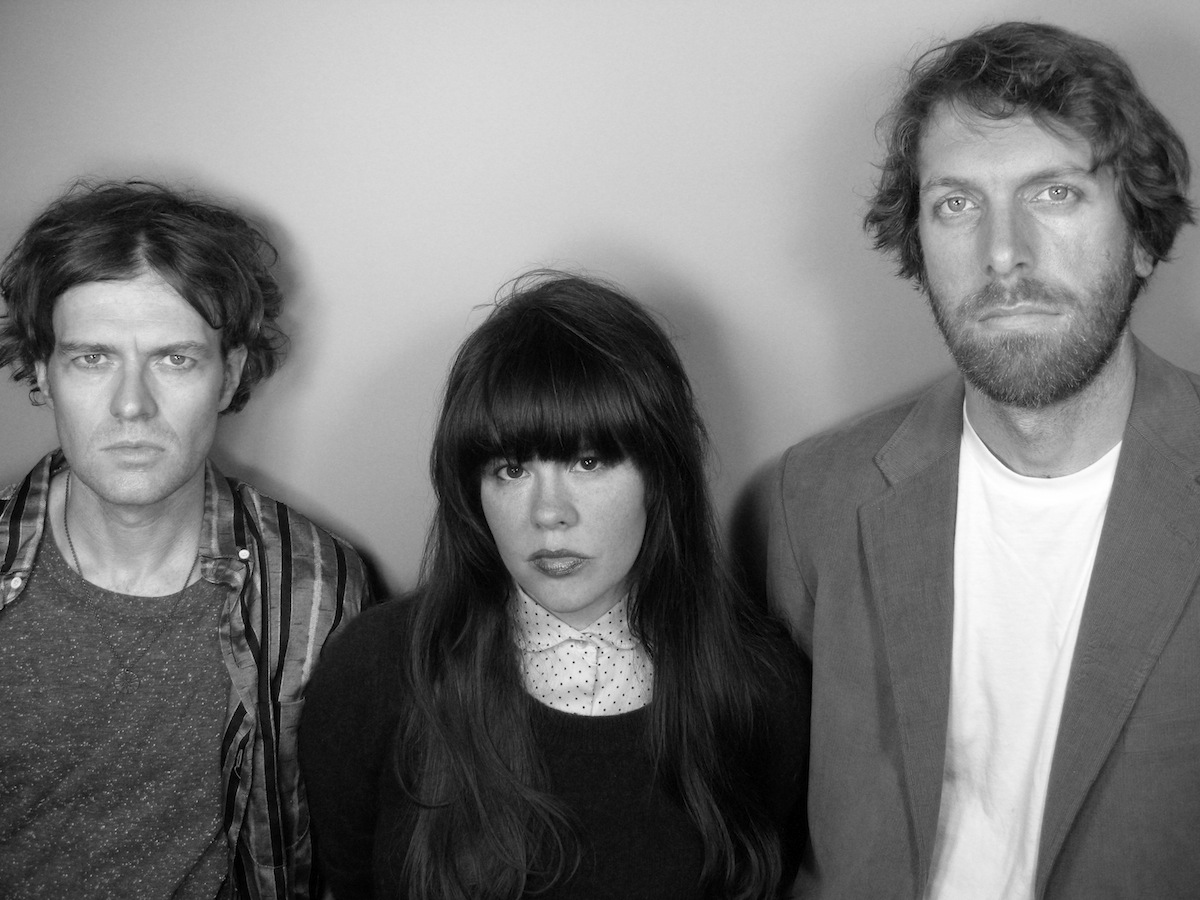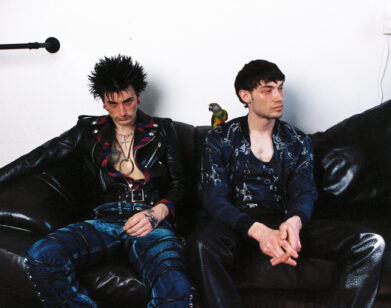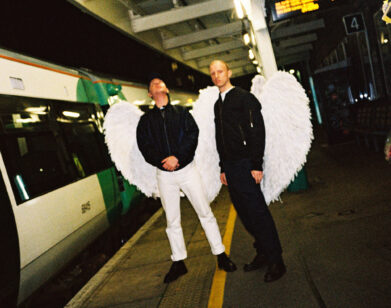Magik Markers Don’t Give Themselves Away

ABOVE: MAGIK MARKERS. IMAGE COURTESY OF ART-UTILITY
Hartford, CT’s most visceral noise-thrashers Magik Markers have kept relatively quiet since the release of their last record, Balf Quarry, in 2009. The band, which began as a trio comprised of Elisa Ambrogio, Pete Nolan, and Leah Quimby, has traipsed from basements to venues, eventually opening for Sonic Youth in 2005. Since 2001, though, the self-proclaimed “New England nerfherders” have severed the division between audience and performer, producer and listener, with their immersive and ramshackle live performances.
On their latest record Surrender to the Fantasy, the Markers reconvene, this time with John “The Saw” Shaw in lieu of Quimby. The triumphant new record finds them trailblazing alien territories of dissonant sounds and un-sounds. It’s a demanding, furious listen thick with hazy reverb, laced with buzzy distortion and Ambrogio’s wistful echoes. Dazzling and disorienting, Surrender to the Fantasy invokes the participation of both your heart and head.
We spoke to the Markers about the meaning of surrender, demented cartoons, and braving strife while writing their triumphant new record.
PAULA MEJIA: I’m struck by the title of your new record, Surrender to the Fantasy. How is surrender as a concept a part of this record?
ELISA AMBROGIO: I guess the idea of the unconscious mind is the idea of when you’re playing music, and making any kind of art, you have to give yourself over to this imaginary kind of world. This world where nothing real happens, because if you actually deal with the reality of your day-to-day existence, you deal with so much quotidian [stuff] you’re concerned with that would reflect in all aspects of what you’re to work on. Even staying alive, even if you think about dying, or decay, it’s sort of paralyzing. So it’s just the idea of giving over to this fantastical thing that allows for the joyfulness to come through, as wanky as that sounds, getting past ego or fear or things that can be in the way when you’re making something. Or, stay alive. [laughs]
PETE NOLAN: Yeah. Just being able to give over to that and not worry about anything else.
JOHN SHAW: I guess it’s the idea of the idea of aiming as high as possibility. That’s part of the fantasy—shooting for that ideal. It takes a certain commitment for something to even come close to that ideal.
NOLAN: Even if it’s not an ideal, just being true to whatever your own weird idea of something is or what it should be, your own sort of personal vision.
SHAW: That’s what I was saying.
NOLAN: Yeah. I just thought of this art retrospectively of [Mike] Kelley’s stuff, I went over and over it again. Trying to remember what he thinks something was or past memory, but it’s true to what his vision was. There was this one thing where he couldn’t remember the design on some t-shirt was, and he drew some really messed-up cartoon animal. Then when he went back and looked at the individual design it was actually the Roadrunner cartoon. What he made from his memory was so much weirder and kind of awesome. Then he did his homework, figured out what it was supposed to be. [laughs]
MEJIA: That’s crazy. What did it look like?
NOLAN: It was really almost an abstract, like, you know, slightly disturbing colorful cartoon. It gives you the creeps, like it’s on the verge of something terrible happening.
MEJIA: I’ve been thinking a lot lately about how kids’ cartoons are way more demented than you remember watching them. I can’t believe I didn’t pick up how violent and weird Ren & Stimpy was when I watched the show as a kid.
NOLAN: Yeah. I loved Ren & Stimpy when I was a kid. I went at some point to this video store that had the stuff that didn’t make it to air. They took it way too far, and it kind of made me depressed and thought, I don’t like this show anymore. But even, like, Bugs Bunny. My kid watches Dora the Explorer, and all these real let’s-be-happy kind of shows. When she tries to watch Bugs Bunny, she freaks out. She can’t watch them. I guess stuff’s gotten way wimpier.
MEJIA: You mentioned having a concrete ideal and having a vision when you create. I’m curious to know if that ideal has evolved as you’ve made music and recorded together over the past 15 years.
AMBROGIO: It’s hard to perceive how that’s progressed, I guess. Other than just more mature principles and aesthetics, I feel like I’m not that different. It’s hard to gauge that. I don’t have a good answer.
NOLAN: It seems like people’s perception of us has changed, though. I feel like people say, “Oh, that band’s always different.” We’ve always had the same ideas and intent, we just have more opportunities to do different things and different times. Every new record, once we had the opportunity to spend time in the studio, we wanted to make the best record we could make. Hopefully something that could stand up over time. I don’t know if we think about it as a progression, just different.
Most of our early recordings were just live gigs. Our M.O. has maybe changed a bit. We never wrote a song in a traditional way— we went out and played. We gradually developed and started thinking more about making songs and records. We’ve been pretty true to our intent, though, to this day.
MEJIA: It’s been four years since you released your last record, Balf Quarry. What have you been doing in that time?
AMBROGIO: It’s kind of weird, because we were always playing together and were working on the record, but stuff just about being alive happened. Like, I had a weird medical thing that was time-consuming where it was hard to concentrate on other stuff. John had two babies, and Pete had one baby. So enormous life things happened. I recorded with another band, and John and Pete made other records. The whole time we were actually playing together—I was living on the West Coast for a while, and came back in 2010.
NOLAN: We were all doing this other stuff, and some things on the record are old, and have been worked out for years and years. It’s kind of cool. We sort of had some impetus, you know, we have a friend in Europe saying, “Oh, when are you going to come play shows here?” And we figured we should probably make a record first. [laughs] You know, there’s been some nice people outside of the band being like, “Come on, guys,” so we have.
AMBROGIO: The other part of that that’s weird, when I first moved back from the West Coast to the East Coast, we were all playing in my dad’s basement and recorded a tape called Isolated From Exterior Time 2010. Our record seems also to be isolated from exterior time—I had no time schedule. I can’t even tell you what stopped it from being done. I have no idea. It literally just created its own time continuum. I can’t explain why at all. We had the bulk of the record done; it created its own really singular space in our brains and in the concept of normal linear time.
SHAW: That’s part of the surrender too, right?
MEJIA: Definitely. Going off of that, how was the writing process different for Surrender to the Fantasy? Were the headspaces you were in different in any way to that of Balf Quarry?
AMBROGIO: I feel like we really gave ourselves the space and time to improvise and not feel that pressure of tour. We just thought, You know what’s awesome? Playing together. Some of the songs on the record are the first time we played them, and thought we’d just jam on that idea or whatever. Over time what changed I guess was, on this record, appreciating how singular and special it is when you get a chance to do something like this.
NOLAN: Yeah. It was cool to take more time on this. Usually what will happen is that we have like, a week and a half to work on it in the studio. And that doesn’t necessarily work. I mean, we take advantage of making it work out however we can, but it was cool being able to record when we could and didn’t feel like we needed to be pressured. It was on our terms. The other thing is, these are as we played them. They’re not heavily edited. All of this was pretty homemade; even the studio stuff was in somebody’s house.
AMBROGIO: This record was so much more positive. On the last record I was in Seattle, where it was really rainy, I had this weird tumor. So this last record was super dark, subject-wise, how I felt. I didn’t realize how dark it was until later.
NOLAN: Yeah, we were definitely a little freaked out and terrified of the future. At least I was. This time we were just having fun and jamming.
MEJIA: I always hear a little black magic in the Markers. How do you keep the magic alive for yourselves?
AMBROGIO: Once you just connect to the reality of doing something and aren’t scared of what anyone thinks of it, that adds a vitality to it. On tour, you’re opening the box with a crowbar. For me that’s how it works. The only self-help book I would ever recommend is called Psychomagic, which is this Jodorowsky work. The subtitle is something like, “The transformative power of shamanic psychotherapy.” It’s really insane, but really great. It’s super positive. It’s not a self-help book in the way it would usually be conceived, but it’s a fearless book about making choices with the unconscious mind. I feel that’s a really positive forward momentum that comes from not being scared. That’s how I keep it going. Maybe part of that magic too is confronting a fear, too. Going the opposite way, maybe using fear as your galvanizing force.
NOLAN: Yeah I’m actually terrified a lot of times when we play. [laughs] I actually have this recurring nightmare where were getting to play, and it’s a really big show with a lot of people. And you [Elisa] and John start playing, and I’m not even halfway set up yet. And it’s like, Ahh! The craziest thing about that is that it’s happened a lot of times in real life. But mostly, playing live is so fun. And it’s not something that we do 300 days of the year, so it makes it adventure time for sure.
SURRENDER TO THE FANTASY IS OUT TOMORROW. FOR MORE ON MAGIK MARKERS, VISIT THEIR PAGE ON DRAG CITY’S WEBSITE.






